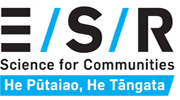ESR is working closely with regional councils and the on-site wastewater industry to assess the impact of OWMS on our public health and the environment, in particular groundwater quality. Understanding the impact this type of wastewater management has on our groundwater quality is vital – especially when that groundwater is used for drinking water.

The diagram above shows the opportunities for microbial removal in an on-site wastewater management system and the receiving environment: 1) the OWMS treatment plant, 2) land application system, 3) vadose zone (unsaturated zone) and 4) saturated zone.
About the research
Contributing to the Three Waters reform, ESR scientists are helping councils throughout Aotearoa NZ in four main OWMS research areas:
1. Estimation of number and location
Canterbury-based ESR scientists, along with Environment Canterbury (ECan), are investigating how Geographical Information Systems (GIS) can be used to estimate the number and location of unknown OWMS. This will help with future risk assessments and resource management planning decisions at a regional and national level.
2. Typical OWMS wastewater quality
ESR and ECan are surveying 30 OWMS (of varying designs, ages, capacities and household occupancy) across Canterbury to determine their chemical and microbiological composition, as well as the presence of Emerging Organic Contaminants (EOCs).
3. Impact on groundwater quality
ESR scientists are also monitoring groundwater quality a domestic OWMS at a field research facility in Canterbury in collaboration with ECan, Hynds, and industry specialists. This research will help guide efforts to improve on-site wastewater operation, maintenance and treatment, and measure the microbial and chemical contribution of the OWMS to the receiving environment.
4. Climate change implications
At the OWMS research facility they're exploring how fluctuating groundwater levels caused by climate change affect this OWMS and potential groundwater contamination.
Members of the OWMS research team. Photo taken by ESR scientist Bronwyn Humphries. From left: Andrew Dakers (ecoENG Ltd), Michael Dawson (Hynds), Roxanne Tane (Hynds), Vaughan Ratahi (All About Sewage). Absent from the photo are: Lisa Scott (Environment Canterbury), Stacey Garrett (Waimakariri District Council), Fiona Ambury (Whiterock Consulting Ltd), Louise Weaver (ESR), Andy Pearson (ESR)
Why is this research important?
New Zealand councils are aware of where consented OWMS are located, but for systems that pre-date resource consent requirements (pre 2000), the location and number of OWMS in a region is often unknown. This creates issues when risk assessments for drinking water supplies are completed, particularly when that drinking water source uses groundwater in an area heavily serviced by OWMS.
There is also not enough research to determine the impact of these systems on groundwater quality and the quality of the wastewater itself for a New Zealand context. New Zealand councils and engineers typically rely on international data to estimate the wastewater quality and risks from OWMS on the surrounding environment and human health. But using international data is problematic because these data are collected from OWMS with different designs, standards, climatic conditions, and therefore different treatment capacities and discharge quality, than those commonly used in Aotearoa.

ESR Senior Scientist Bronwyn Humphries samples an OWMS.
The impact of climate change
Our changing climate makes this research even more important. From droughts to intense rainfall, New Zealand is experiencing an increased frequency of extreme weather events, resulting in rapidly fluctuating groundwater levels. This increases the potential for groundwater to mix with on-site wastewater, which is a risk to groundwater drinking water sources.
Project leader Dr. Louise Weaver says: "Instead of a ‘flush and forget’ mentality, ESR is helping to shine a light on the risks associated with on-site wastewater so that our communities and environment are protected and treasured as a taonga.

ESR interns Gemma Langley (foreground) and Rachel Qiu (background) monitoring groundwater at the Canterbury OWMS research facility.
Find out more
For more information about the research, contact Louise Weaver (science leader) or Bronwyn Humphries (project lead).
For more information about onsite wastewater management system, check out ECan’s wastewater information.(external link)
